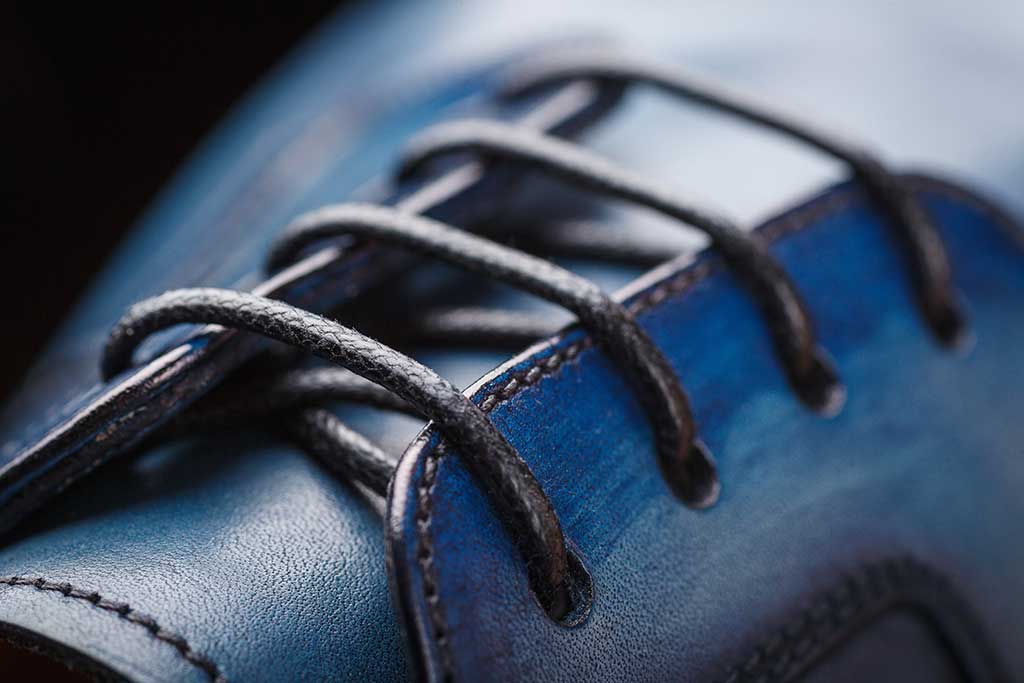Why are some shoelaces waxed?

Have you ever noticed that some laces are specifically made to withstand the elements? Waxed laces are a popular choice, not only for their aesthetic appeal, but also for their exceptional properties in terms of resistance and durability. Faced with the elements or daily wear and tear, these laces offer significant advantages, such as increased protection against moisture and improved robustness.
But what are the different types of laces available, and how can they become your allies in the care and maintenance of your footwear? By exploring the many benefits of waxed laces and learning how to care for them properly, you'll discover the secrets of increased longevity for your favorite fashion accessories. Let's dive together into this fascinating world of waxed laces and their many benefits.

What benefits do waxed laces bring in terms of resistance to water and wear?
Waxed laces are not simply an aesthetic ornament, but a real revolution for those seeking durability and performance. Imagine yourself hiking in the pouring rain, or racing through cobbled city streets. Your shoes are put to the test, and that's where waxed laces come in.
Protection against moisture
One of the major advantages of waxed laces is their ability to repel water. The wax applied to the laces creates an impermeable barrier that prevents water from penetrating the fabric. This means that even in a torrential downpour, your laces will stay dry and maintain their structural integrity. Ever had soggy laces that warp and become difficult to tie? With waxed laces, this problem is a thing of the past.
Durability and robustness
Beyond protection against moisture, waxed laces also offer increased robustness in the face of everyday wear and tear. Studies show that leathers treated with specific lubricants such as wax 213 have up to 25% greater resistance to tearing. This significant improvement translates into laces capable of withstanding constant friction and repeated strain without fraying or breaking.
Let's take a concrete example: imagine a sportsman using his shoes for various intense activities, such as trail running or soccer. The sudden movements and rapid changes of direction put enormous pressure on the shoe's fastening points. Ordinary laces might quickly show signs of weakness, but those treated with an appropriate wax will retain their strength for longer.
It's this unique combination of moisture protection and improved durability that makes waxed laces a must-have choice for anyone looking not only to extend the life of their shoes, but also to ensure optimum comfort in all conditions.
How to care for waxed laces to maximize their lifespan
Effective cleaning of waxed laces
To preserve the beauty and functionality of your waxed laces, it's essential to clean them regularly. Proper care starts with thorough dusting using a soft brush. Next, use a slightly damp cloth to remove embedded dirt without damaging the protective wax. Avoid harsh chemicals that could alter the lace's finish.
Let's take the example of an avid sportsman who uses his running shoes daily: by cleaning his laces after each use, he ensures not only impeccable appearance but also increased longevity.
Waxing and preservation techniques
The wax applied to your laces plays a crucial role in their durability and resistance to the elements. To maintain this protection, we recommend reapplying a thin layer of specific wax (such as that mentioned in leather studies) every few months. Use a suitable wax such as wax 213, recognized for its superior effectiveness to wax 212. This regular application not only improves tear resistance but also ensures optimum protection against moisture.
Also remember to store your shoes in a dry, well-ventilated place, away from direct sources of heat or excessive humidity. For example, avoid leaving your shoes with their polished laces near a radiator or in a damp bathroom.
By following these simple but effective tips, you'll be able to maximize the lifespan of your polished laces while maintaining their aesthetic and functional appearance. Imagine yourself at an important meeting or major sporting event with impeccably cared-for shoes; it boosts your confidence and reflects your attention to detail.
Why are some laces waxed?
The waxed laces are not only a matter of style, but also of functionality. Imagine walking in the pouring rain or taking part in an intense hike: your laces need to stay firmly tied and stand up to the elements. That's where the magic of waxed laces comes into play, especially in terms of water and wear resistance.
Use in dress shoes and sports shoes
Waxed laces find their place in both elegant footwear and sports equipment. For fashion lovers, a waxed lace offers a smooth, shiny finish that enhances the elegance of a pair of leather shoes. But that's not all! Sports enthusiasts will also appreciate the sturdiness and reliability of waxed laces, which stay firmly in place even during the most intense movements. Have you ever wondered why your shoes come untied less often with waxed laces? It's because of the increased friction between the lace fibers and the outer material, ensuring a more stable knot.
Aesthetics and finish of waxed laces
The aesthetic aspect of waxed laces is undeniable. Their slightly rigid texture not only ensures a better knot hold, but also adds a sophisticated touch to your favorite shoes. Think of those moments when you need to impress at an interview or important meeting: every detail counts, including your impeccably knotted laces that won't come undone at the slightest movement.
In addition, certain types of wax like the 213 wax mentioned by Chahine (2013) show impressive results on leather. Regular application not only improves appearance but also increases tear resistance by up to 25%. By choosing laces treated with these specific waxes, you're investing in a durable accessory that will stand the test of time.
So, whether you're a professional concerned about your appearance or an athlete seeking performance and durability, waxed laces are the perfect answer to these varied needs.
We recommend these other pages:
